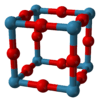Rhenium trioxide
| Rhenium trioxide | ||
|---|---|---|
 |
 | |
| IUPAC name Rhenium trioxide | ||
| Other names Rhenia | ||
| Identifiers | ||
| CAS number | 1314-28-9 | |
| PubChem | 102110 | |
| EC number | 215-228-8 | |
| Jmol-3D images | {{#if:O=[Re](=O)=O|Image 1 | |
| ||
| ||
| Properties | ||
| Molecular formula | ReO3 | |
| Molar mass | 234.205 g/mol | |
| Appearance | Deep red crystals | |
| Density | 6.92 g/cm3 | |
| Melting point | 400 °C (decomposes) | |
| Refractive index (nD) | 1.68 | |
| Structure | ||
| Crystal structure | Cubic, cP4 | |
| Space group | Pm3m, SpaceGroup = 221 | |
| Except where noted otherwise, data are given for materials in their standard state (at 25 °C (77 °F), 100 kPa) | ||
| Infobox references | ||


Rhenium trioxide or rhenium(VI) oxide is the inorganic compound with the formula ReO3. It is a red solid with a metallic lustre. It is the only stable trioxide of the Group 7 elements (Mn, Tc, Re).
Structure
Rhenium oxide forms crystals with a primitive cubic unit cell, with a lattice parameter of 3.742 Å (374.2 pm). The structure of ReO3 is similar to the Perovskite structure (ABO3), without the large A cation at the centre of the unit cell. Each rhenium atom is surrounded by an octahedron of six oxygen centers. These octahedra share corners to form the 3-dimensional structure. The coordination number of O is 2 because each oxygen atom has 2 neighbouring Re atoms.[1]
Properties
ReO3 is unusual for an oxide because it exhibits very low resistivity. It behaves like a metal in that its resistivity decreases as its temperature decreases. At 300 K, its resistivity is 100.0 nΩ·m, whereas at 100 K, this decreases to 6.0 nΩ·m, 17 times less than at 300 K.[1]
Preparation
Rhenium trioxide can be formed by reducing rhenium(VII) oxide with carbon monoxide. [2]
- Re2O7 + CO → 2 ReO3 + CO2
References
- ↑ 1.0 1.1 Greenwood, Norman N.; Earnshaw, Alan (1997). Chemistry of the Elements (2nd ed.). Butterworth-Heinemann. ISBN 0080379419., p. 1047.
- ↑ H. Nechamkin, C. F. Hiskey, A. D. Melaven, ,J . N. Fowle, W. Brickell, C. F. Hiskley "Rhenium(VI): Oxide (Rhenium Trioxide)" Inorganic Syntheses, 1950 Volume 3, pp. 186-188. doi:10.1002/9780470132340.ch49
| ||||||||||||||||||||||||||||||||